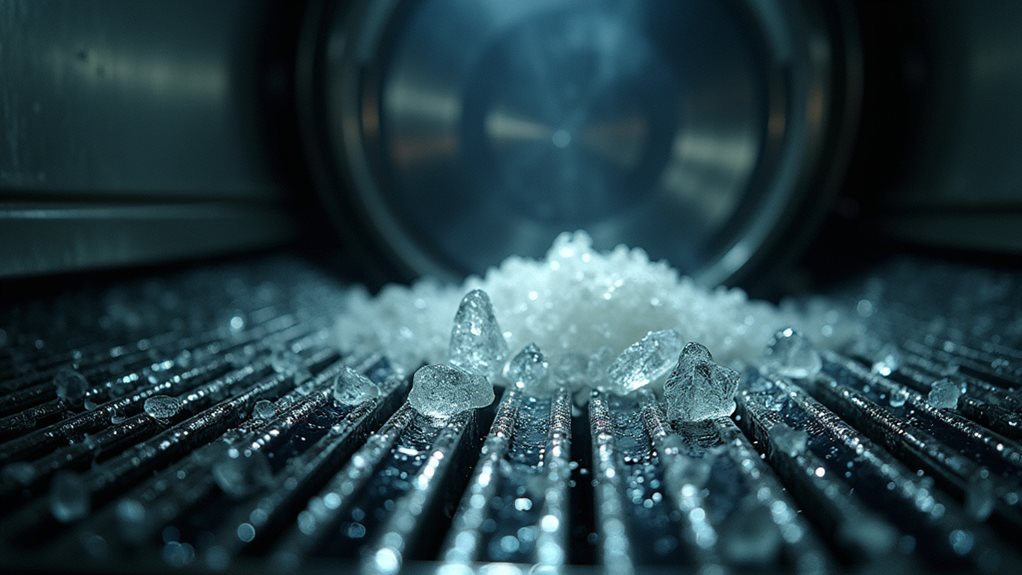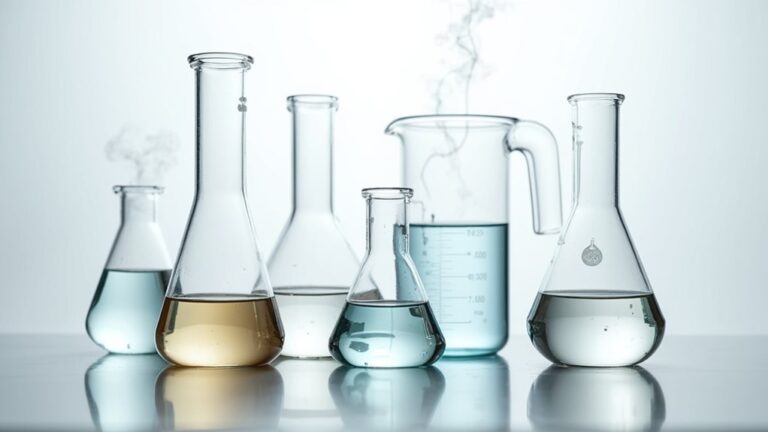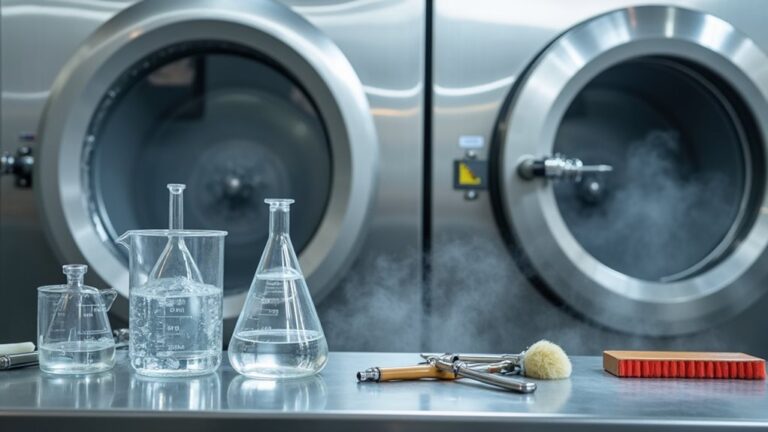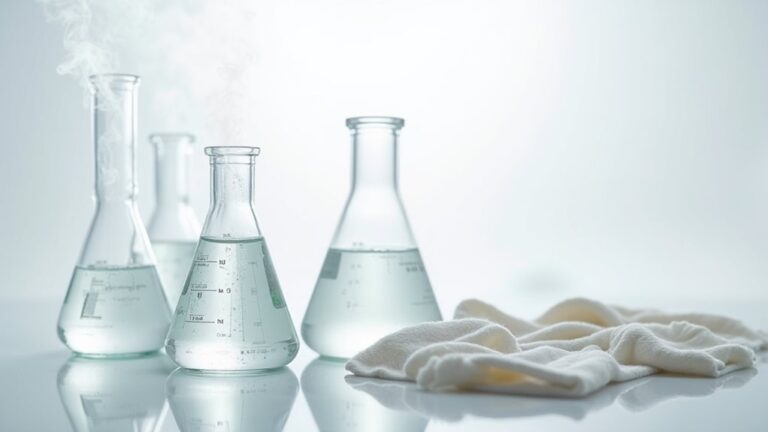Traditional dry cleaning does pose cancer risks through perchloroethylene (PCE), a probable human carcinogen that clings to your freshly cleaned clothes and releases vapors when you’re getting dressed or even just opening your closet. You’re most at risk if you work in the industry, with a 20% increased cancer mortality rate, though living near dry cleaners or frequently wearing treated garments also heightens your exposure to bladder cancer and lymphoma risks—but safer alternatives exist that’ll protect your health.
The Science Behind Dry Cleaning and Chemical Exposure
When I first learned that my favorite wool sweater might be harboring invisible chemicals after dry cleaning, I’ll admit I felt a bit betrayed by what seemed like such a harmless service.
That moment when you realize your trusted dry cleaner might be coating your clothes in invisible toxins.
Here’s what you need to know about chemical exposure: traditional dry cleaning uses perchloroethylene (PCE), a solvent that doesn’t play nice with your body.
Think of PCE as that friend who overstays their welcome – it clings to fabrics long after the cleaning process ends, especially wool and polyester.
When you bring those clothes home, you’re potentially breathing in these chemicals every time you open your closet or wear the garments.
The International Agency for Research on Cancer has classified PCE as a probable human carcinogen, linking it to bladder cancer and non-Hodgkin lymphoma.
Studies have also shown connections between occupational exposure and increased risks of esophageal cancer and cervical cancers among dry cleaning workers.
Perchloroethylene: The Primary Carcinogenic Culprit

When you’re trying to understand why dry cleaning raises cancer concerns, you’ll find that perchloroethylene (PERC) sits at the center of this health puzzle like an unwelcome guest who won’t leave the party.
The International Agency for Research on Cancer has classified PERC as a probable human carcinogen, which honestly sounds scarier than it needs to—but it’s basically their way of saying there’s solid evidence this chemical could cause cancer in people.
If you’ve ever wondered why dry cleaning workers face higher health risks, it’s because they’re exposed to PERC daily, and studies show they’re more likely to develop bladder cancer, non-Hodgkin lymphoma, and multiple myeloma than folks in other professions.
Beyond cancer concerns, PERC exposure has also been linked to neurological problems, liver damage, and reproductive issues that can affect both workers and consumers who frequently use traditional dry cleaning services.
PERC Cancer Classification
Although I’ve spent years reassuring friends that their dry-cleaned clothes were perfectly safe, the truth about perchloroethylene (PERC) finally caught up with my well-meaning but misguided confidence 😅.
The International Agency for Research on Cancer doesn’t mince words when it comes to this widespread dry cleaning solvent. They’ve classified PERC as a Group 2A probable human carcinogen, which means the evidence is strong enough to make you think twice about that freshly cleaned suit.
Here’s what the research reveals about these cancer-causing chemicals:
- Bladder cancer risks increase considerably among dry cleaning workers.
- Non-Hodgkin lymphoma shows troubling connections to PERC exposure.
- Multiple myeloma rates climb with prolonged chemical contact.
The EPA agrees, labeling this carcinogen as a likely threat and implementing phase-out regulations across the industry.
PERC residues can linger on garments even after the cleaning process, particularly when clothes aren’t given adequate time to air out before wearing, which can expose consumers to these harmful chemical solvents through skin contact and inhalation.
Worker Exposure Risks
Behind every perfectly pressed shirt lies a sobering reality that most of us never consider: dry cleaning workers face some of the highest occupational cancer risks in America, with their daily exposure to perchloroethylene creating a workplace environment that’s fundamentally a slow-motion health crisis.
When you think about worker exposure, imagine spending eight hours daily breathing in PCE vapors—it’s like working inside a chemical cloud that slowly accumulates in your body.
These dedicated professionals don’t just face immediate symptoms like dizziness and headaches; they’re dealing with considerably increased cancer risk, particularly for bladder cancer and non-Hodgkin lymphoma.
Despite EPA regulations pushing for safer alternatives, many facilities still rely on perchloroethylene (PCE), leaving workers vulnerable to long-term health consequences that extend far beyond their paychecks.
Fortunately, some dry cleaning facilities are transitioning to safer alternatives like wet cleaning, liquid CO2, and hydrocarbon solvents that significantly reduce worker exposure to harmful chemicals.
Cancer Risks for Dry Cleaning Workers
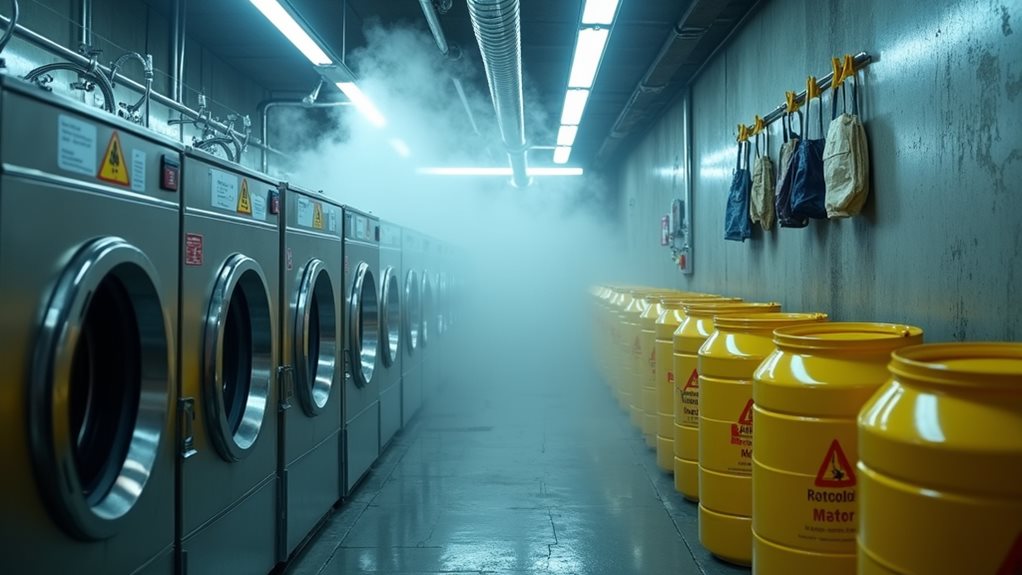
While most of us only think about cancer risks when we’re the ones dropping off our favorite blazer at the dry cleaner, the people who work behind those counters face a much more serious reality every single day.
Dry cleaning workers experience prolonged exposure to perchloroethylene (PCE) and trichloroethylene, chemicals that IARC has classified as probable or definitive human carcinogens. The cancer risks are genuinely alarming – studies show these workers face a 20% increase in overall cancer mortality compared to the general population.
Behind every pressed shirt lies a hidden crisis – dry cleaning workers face 20% higher cancer mortality from daily exposure to proven carcinogens.
The specific cancers linked to their daily chemical exposure include:
- Bladder cancer from repeated PCE contact
- Non-Hodgkin lymphoma through solvent inhalation
- Multiple myeloma from long-term chemical exposure
These aren’t just statistics; they’re real people whose livelihoods unknowingly compromise their health. Studies have also suggested potential links to esophageal and kidney cancers among those with occupational exposure to these chemicals.
Health Hazards for Consumers and Nearby Residents
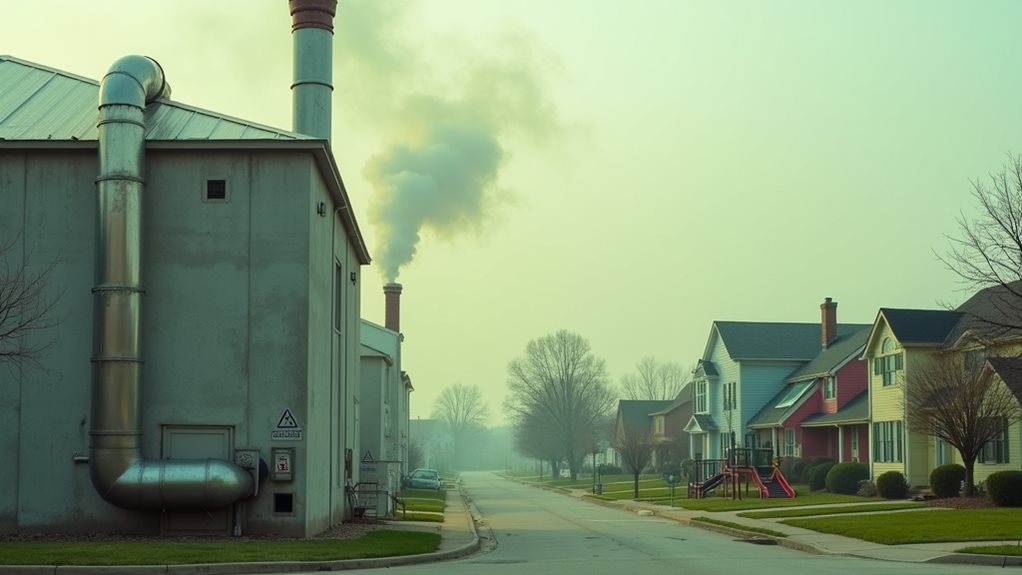
You don’t have to work in a dry cleaning shop to face potential cancer risks from PCE, as simply wearing freshly cleaned clothes or living near these facilities can expose you to this likely carcinogen.
When you pick up your favorite wool coat or cotton dress shirt, studies show these fabrics can retain considerable levels of perchloroethylene that you’ll breathe in throughout the day – something I never considered until my neighbor mentioned the chemical smell from her dry-cleaned curtains.
If your home or apartment sits within a few blocks of a dry cleaning operation, you’re practically living in a zone where volatile organic compounds drift through the air, creating what researchers have identified as measurable cancer risks for entire neighborhoods.
Beyond cancer concerns, PERC exposure can also cause nervous system damage and respiratory problems that affect both workers and customers who come into contact with treated garments.
Residential Exposure Risks
When you pick up your freshly dry cleaned blazer and hang it in your bedroom closet, you’re unknowingly inviting perchloroethylene (PCE) into your most intimate living spaces, where this probable carcinogen can linger on fabric fibers and slowly release into your home’s air for days or even weeks.
This residential exposure creates health risks that extend far beyond the dry cleaning shop itself.
The EPA’s classification of PCE as a probable human carcinogen should make you pause before bringing those clothes inside.
Your family faces potential exposure through three main pathways:
- Inhaling vapors from freshly cleaned garments hung in closets
- Skin contact when wearing clothes with chemical residues
- Contaminated indoor air circulating throughout your living spaces
I’ve learned to air out dry cleaned items outdoors first—a simple step that dramatically reduces these invisible threats.
Beyond cancer concerns, prolonged exposure to PERC can also trigger neurological symptoms and respiratory irritation that affect your daily well-being.
Chemical Retention Concerns
The troubling reality becomes even more complex when you consider that PCE doesn’t simply vanish once your clothes leave the dry cleaner—it clings to fabric fibers like an unwelcome houseguest, creating a slow-release system that exposes you, your family, and even your neighbors to this probable carcinogen for weeks after cleaning.
Georgetown University researchers discovered that wool, cotton, and polyester fabrics all retain notable PCE levels, which then vaporize into your home’s air. This invisible threat poses serious public health concerns, especially since the EPA has classified PCE as a likely human carcinogen.
Without federal regulations limiting its use, you’re practically playing chemical roulette every time you bring freshly dry-cleaned items home, unknowingly increasing PCE exposure risks for everyone around you. Beyond immediate exposure concerns, PCE contamination can also contribute to environmental pollution that affects groundwater and soil quality in areas surrounding dry cleaning facilities.
Proximity Cancer Links
Living within shouting distance of a dry cleaner might seem convenient when you’re rushing to pick up your work clothes, but research paints a sobering picture that’ll make you reconsider that proximity perk.
Studies reveal that living near PCE-using facilities considerably increases cancer risks, particularly for kidney, bladder, and non-Hodgkin lymphoma cases.
The data speaks volumes about proximity dangers:
- Quarter-mile radius residents face markedly heightened cancer rates
- 25% increase in cancer mortality for those living near PCE facilities
- Limited monitoring by local health departments leaves you vulnerable
What’s particularly unsettling? You might be breathing contaminated air or drinking affected groundwater without knowing it.
The EPA acknowledges these emissions create hazardous air pollutants, yet routine monitoring remains spotty at best.
The chemical responsible for these health concerns is perchloroethylene (PERC), which the EPA has classified as a probable human carcinogen and is the most commonly used solvent in the dry cleaning industry.
Regulatory Actions and Bans on Toxic Solvents
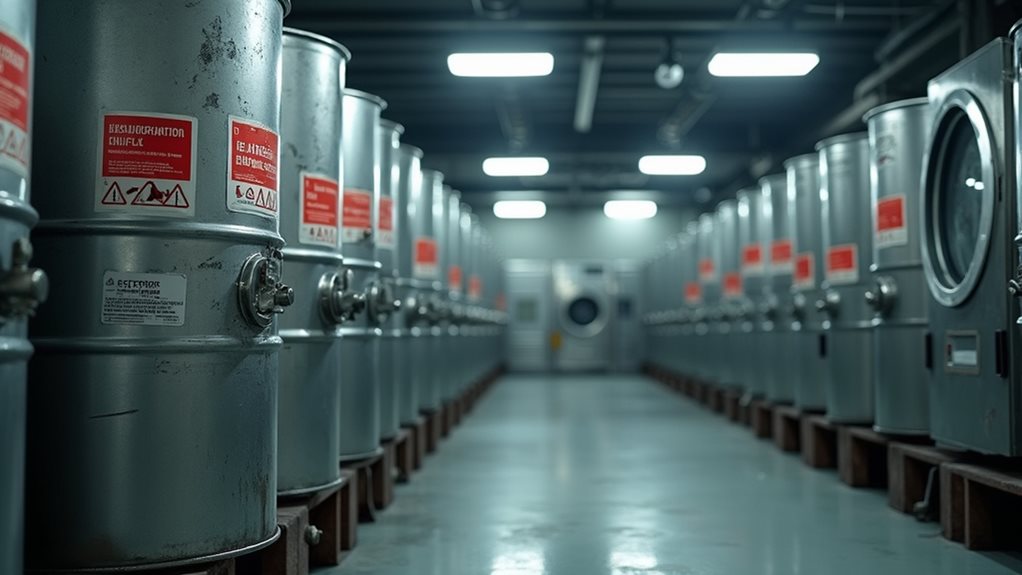
Although I’d love to tell you that government agencies jumped on this health crisis immediately, regulatory actions on toxic dry cleaning solvents has been frustratingly slow, like watching paint dry in a humid room.
Government agencies moved at glacial speed on dry cleaning toxins, taking decades to act on known carcinogens.
The EPA finally banned trichloroethylene and began phasing out PERC—both known carcinogens—but this happened decades after scientists identified the risks.
California led the charge in 2007, setting a 2023 deadline to eliminate PERC use, while states like New York and Illinois followed suit with their own restrictions.
Here’s what’s encouraging though: new workplace exposure limits could reduce worker risk by 97%, protecting roughly 160,000 employees.
The sobering reality? About 30-35% of dry cleaners still used PERC as of 2023, proving change takes time. 🕰️
Beyond workplace hazards, these toxic solvents can contaminate soil and groundwater when facilities don’t properly handle chemical waste disposal.
Emerging Alternatives and Their Safety Profiles

While traditional solvents face increasing restrictions, you’ll find that dry cleaners aren’t sitting around twiddling their thumbs—they’re actively exploring alternatives that promise to be safer for both workers and customers.
These emerging alternatives to perc come with varying health implications, and honestly, it’s like watching a science experiment unfold in real-time.
The three main contenders making waves include:
- Propylene glycol ethers (PGEs) – biodegradable options with established safety limits
- Siloxane (D5) – marketed as gentler but lacking thorough toxicity data
- High-flashpoint hydrocarbons – promising yet under-researched regarding long-term effects
However, not all emerging alternatives hit the mark—n-propyl bromide, for instance, turned out to be a “regrettable substitution” with potential carcinogenic properties, reminding us that newer doesn’t always mean safer.
How to Minimize Your Exposure Risk

Since knowledge is power when it comes to protecting your health, you don’t have to become a hermit who avoids dry cleaning altogether—you just need to become a savvy consumer who asks the right questions and takes simple precautions.
Start by chatting with your dry cleaner about their cleaning chemicals, specifically requesting safer alternatives like liquid carbon dioxide instead of those harsh solvents we discussed earlier.
Ask your dry cleaner about safer cleaning alternatives like liquid carbon dioxide instead of traditional harsh chemical solvents.
When you pick up freshly cleaned garments, resist the urge to immediately hang them in your closet—I learned this the hard way after my bedroom smelled like a chemical factory for days!
Instead, let them breathe outdoors for several hours to minimize exposure to lingering vapors.
Consider investing in air purifiers with VOC-rated filters, and explore gentle at-home cleaning methods for delicate items.
Safer Cleaning Methods for Your Garments

When I discovered that my favorite silk blouse didn’t actually need to be subjected to harsh chemical baths, it felt like finding out I’d been taking the scenic route to work for years—totally unnecessary!
You’ve got plenty of safer cleaning methods that’ll keep your delicate garments looking fabulous without the toxic drama.
Here are three game-changing alternatives worth exploring:
- Wet cleaning uses biodegradable detergents and water instead of harsh solvents.
- Liquid CO2 cleaning recycles carbon dioxide to remove stains without toxic residues.
- Silicone-based systems like GreenEarth® offer gentler treatment for fabrics.
Each eco-friendly alternative protects both your health and the environment while delivering excellent results.
Don’t forget about home dry cleaning kits either—they’re perfect for revitalizing garments between professional cleanings! 🌿

